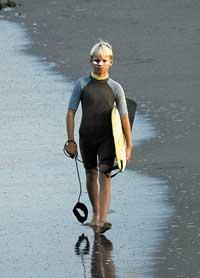Copy, patent, enrich. History of Velcro

George de Mestral (1907-1990) had since childhood the passion for inventing himself. Imagine that he received his first patent at the age of twelve for designing a toy plane. In addition, his inventions triumphed and very young decided that he would be an engineer. He did all kinds of work at the Federal Polytechnic School of Lausanne to pay for his studies, but he fulfilled his dream of obtaining the degree of electrical engineer.
But to live from one's inventions is not something improvised, and after finishing his studies he joined a machine company. However, it did not change course, and in the 1940s he had an idea that would change his life after hunting.
It is not very clear the year in which he took his happy walk; in some sources it is cited the year 1942, in others the year 1948. Well. De Mestral liked to walk in the mountains and in the hunt, and in that decade probably would have given hundreds of laps. Therefore, in any of them, he returned home and studied under a microscope the lapel herbs that were stuck to the dog's clothes and hair. Perhaps he would be fed up with removing them and wanted to know how the demons were so well added.
The microscope immediately taught him the secret of flap grass. The seeds had hundreds of small hooks and thanks to them they stuck so well. In clothes, for example, they hook into the holes in the fabric and then it is very difficult to remove them.
De Mestral decided to use this secret for his own benefit and spent the following years discovering how to imitate nature.
Imitate and enrich nature
De Mestral wanted to invent a closure that worked as lapas herbs. The closure had hooks on one side; on the other, ear shaped structures to preside over these hooks and, by pressing one against the other, they would stick with the same solidity as the herbaceous lapels. It would compete with the zipper.

The inventor went to Lyon in search of help to develop the idea, capital of the textile industry at that time. But the legend says that few supported the idea of Switzerland and those who liked them did not want to risk money. Only a weaver who worked by hand wanted to work with De Mestral.
Then, they left the engineering job, asked for a loan to the bank and started looking for the most suitable fabric to make the closure. The first successful design was with cotton, but the process was too expensive to extend it a lot. So one hundred others were tried. Finally, with the help of the microscope, De Mestral found a solution. While watching with infrared light, he discovered that nylon produces almost indestructible hooks. This is how Velcroa® was born. Its name is due to the French words ‘velours’ and ‘crochet’. ‘Velours’ is used to designate a carved plush in a certain way and ‘crochet’ means hook.
De Mestre patented the invention in Switzerland in 1951 and a year later founded the company Velcro S.A. In the following years he did the same in other European countries, Canada and the United States, that is, he obtained patents. In this way, only he, and no one else, could produce those revolutionary closures. At the end of the 1950s it was evident that the Swiss engineer had been successful in full. By then it sold almost 55,000 Velcro® kilometers per year.

At present this type of closures is used almost for everything. It is very common in leather goods, medicine, orthopedics, automotive industry or space. But against what many believe, velcro® is not an invention due to space research. The space has been an important field of application, but it was not created specifically for it.
King of the market until 1979Thanks to his responsibility in obtaining patents, until 1979 no one was able to manufacture closures like those of De Mestral if the rights were not paid well. However, that year the patent of origin expired and since then the company's struggle has been its name. They and no one else can produce the products called velcro®. Just as it has happened with nylon, cellophane or kleenex, they do not want the name of their product to become generic and take care with great care that the symbol of the trademark appears next to the name.





